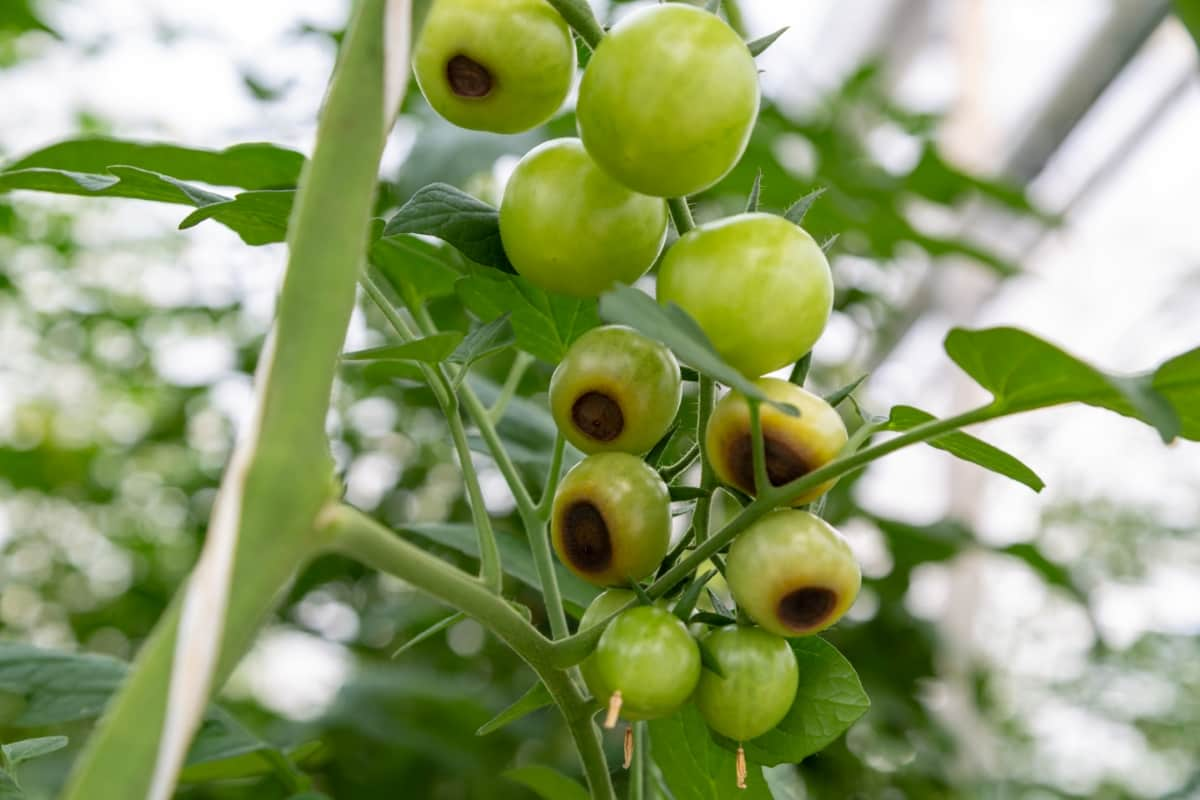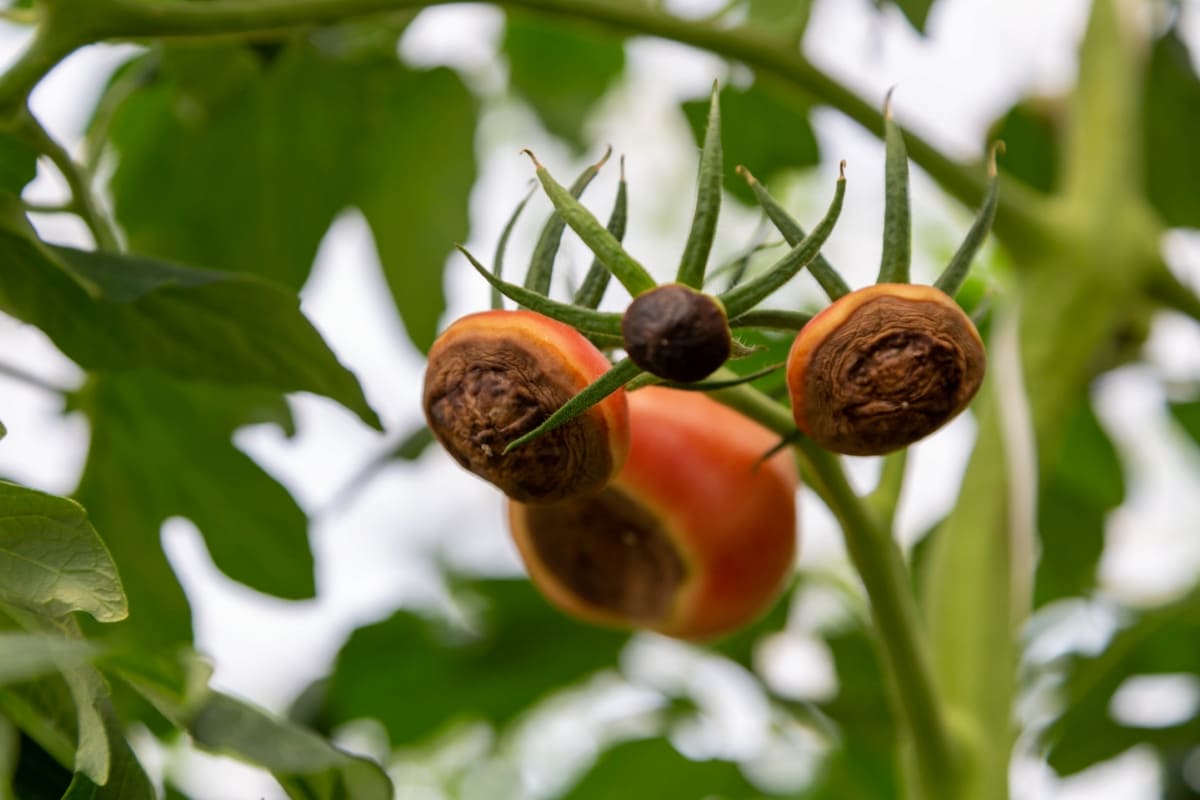Gardening enthusiasts often face the challenge of tomato blossom end rot, a disheartening condition that can spoil the hard work of nurturing tomato plants. This condition is preventable and manageable with the right know-how. Baking soda, a natural and readily available kitchen ingredient, can be an effective preventive measure.

Understanding how to use baking soda to prevent tomato blossom end rot is vital, from knowing when to put baking soda on tomato plants to recognizing that too much baking soda can be detrimental. Additionally, it’s essential to grasp how often to spray tomato plants with baking soda while considering its potential to make tomatoes sweeter and its combined use with aspirin. This article explores how baking soda can play a role in preventing blossom end rot, ensuring that your tomato plants remain healthy and productive.
Baking Soda to Prevent Tomato Blossom End Rot
Understanding Tomato Blossom End Rot: Causes and Symptoms
Tomato blossom end rot is a common issue for gardeners. It happens when the end of the tomato farthest from the stem turns brown or black and becomes sunken. It’s caused by a lack of calcium in the tomato’s tissues, which can be due to low calcium levels in the soil or uneven water supply. The symptoms usually appear when the fruit is growing. If you see these signs, it means your plants are calling for help. Fixing the problem early is key to enjoying a healthy tomato harvest.
The Role of Calcium in Preventing Tomato Blossom End Rot
Calcium is crucial for tomatoes. It helps them grow well and prevents blossom end rot. This nutrient helps build strong cell walls in the developing fruit. When calcium is low, the tissues break down, leading to rot. Ensuring your soil has enough calcium and water can help stop this problem. It’s a balancing act: too little water and the plants can’t take up calcium; too much and the nutrient gets washed away. Consistent watering is a must.
How Baking Soda Can Help Prevent Tomato Blossom End Rot
Baking soda is a natural tool to prevent blossom end rot. It boosts the soil’s pH level, which can help calcium be more available to your plants. Baking soda also helps in reducing acidity, which can make tomatoes sweeter. It’s a handy trick for gardeners looking to improve their tomato crop. Remember, the goal is to prevent the rot, not to cure it once it’s started. Starting early in the season is your best bet for success.
Step-By-Step Guide: Using Baking Soda to Treat Tomato Blossom End Rot
To stop tomato blossom end rot with baking soda, just mix one tablespoon of baking soda with a gallon of water. This is your spray solution. When putting baking soda on tomato plants, it is important to do it in the early morning or late afternoon to avoid the day’s heat. Gently spray the soil around the tomato plants, not the plants themselves. How often should you spray? Once every two weeks should be enough. Be careful not to overdo it because too much baking soda can harm your plants.
In case you missed it: Effective Strategies for Tomato Grafting: Benefits, Techniques, and Varieties to Consider

Dos and Don’ts: Best Practices for Applying Baking Soda to Prevent Blossom End Rot
When using baking soda on your tomato plants, there are some best practices to follow. Do test your soil first to see if it’s acidic. If it is, baking soda can help. Do water your plants regularly to keep calcium flowing. But don’t apply baking soda directly to the plants, as it can burn them. And don’t use too much; it can build up in the soil and cause problems. A light, consistent approach is the way to go.
Exploring the Science Behind Baking Soda’s Effectiveness in Treating Tomato Blossom End Rot
Baking soda’s science in preventing tomato blossom end rot is about balance. It changes the soil’s pH, which helps calcium availability. This change can deter rot and even enhance flavor. The sodium in baking soda helps the plant take up nutrients more efficiently. However, the key is to use it correctly. Too much can lead to a buildup of sodium, which is bad for plants. The right amount can mean the difference between a poor harvest and a bountiful one.
Alternative Methods for Preventing Tomato Blossom End Rot Using Baking Soda
Besides spraying the soil, there are other ways to use baking soda. Mixing it into tomato sauce can neutralize acidity. Some gardeners even add aspirin and baking soda to tomatoes to boost their immune systems. But it’s not just tomatoes that benefit from baking soda; other plants like it, too. For example, it can help flowers bloom brighter and prevent fungal diseases. It’s a versatile, natural product that can support a healthy garden when used wisely.
In case you missed it: Tomato Farming with Biodynamic Practices for Better Crop Health and Yield

Common Mistakes to Avoid when Using Baking Soda for Tomato Blossom End Rot Prevention
Applying baking soda to prevent tomato blossom end rot can be tricky, and some common mistakes must be avoided to ensure the health of your plants. Over-application is a frequent error; too much baking soda can lead to a sodium buildup, harming the plant’s root system and soil quality. It’s also crucial not to apply baking soda directly onto the foliage or fruits, as this can cause burn and additional plant stress.
Another mistake is irregular application; inconsistent use will not provide the stable environment that tomato plants need to absorb calcium effectively and can disrupt the soil’s pH balance. Lastly, relying solely on baking soda without addressing other cultural practices such as proper watering, soil management, and balanced fertilization can lead to disappointment. For optimal health and prevention of blossom end rot, baking soda should be part of a comprehensive plant care strategy.
Long-Term Strategies: Incorporating Baking Soda into Your Tomato Plant Care Routine
For a long-term strategy, incorporating baking soda into your tomato plant care routine should be done with a sustainable approach. Begin by adding compost and the right fertilizers to the soil to make sure it has the right nutrients, like calcium. Consistent watering practices are vital, as they help prevent fluctuations hindering calcium uptake. Baking soda should be applied sparingly, focusing on maintaining soil pH rather than drastic alteration.
In case you missed it: Summer Tomato Farming: Instructions to Grow Tomatoes in the Hottest Months

Monitoring the soil’s pH over time can inform you about the necessity of further applications. Also, consider companion planting and crop rotation to maintain soil health. By adopting these practices, you can create an environment where tomatoes are less likely to develop blossom end rot and baking soda is used effectively as a preventive, rather than a reactive, solution.
Conclusion
Using baking soda to prevent tomato blossom end rot is a natural method that, when applied correctly, can yield sweet and healthy fruits. It’s important to remember the role of calcium in this prevention, the correct application of baking soda, and the common mistakes to avoid. Consistent, long-term strategies are crucial for effectively integrating baking soda into your tomato care routine.
With careful attention and the right practices, baking soda can be a beneficial addition to your gardening toolkit, helping to ensure a robust and vibrant tomato harvest. Consider the broader picture of plant health, as a combination of good practices will lead to the best results in your garden.
- Feed Your Flock for Less: Top 10 Tips to Save on Chicken Feed
- Ultimate Guide to Ossabaw Island Hog: Breeding, Raising, Diet, and Care
- Hatching Answers: The Top 10 Reasons Your Chickens Aren’t Laying Eggs
- Eggs and Economics: Breaking Down the Cost of Raising Backyard Chickens
- Defend Your Greens: Proven Methods to Keep Iguanas Out of Your Garden
- Ultimate Guide to Cinnamon Queen Chicken: A Comprehensive Guide for Beginners
- Ultimate Guide to California Tan Chicken: Breeding, Raising, Diet, Egg-Production and Care
- Ultimate Guide to Marsh Daisy Chicken: Breeding, Raising, Diet, and Care
- 10 Types of Chicken Farming Businesses You Can Start for Profits